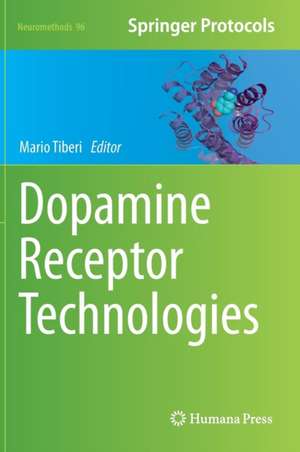Dopamine Receptor Technologies: Neuromethods, cartea 96
Editat de Mario Tiberien Limba Engleză Hardback – 4 dec 2014
Practical and versatile, Dopamine Receptor Technologies seeks to aid researchers in developing new pharmacological tools to improve our knowledge of in vivo roles played by each receptor subtype and the synthesis of prospective lead compounds for drug discovery.
| Toate formatele și edițiile | Preț | Express |
|---|---|---|
| Paperback (1) | 785.06 lei 6-8 săpt. | |
| Springer – 23 aug 2016 | 785.06 lei 6-8 săpt. | |
| Hardback (1) | 657.73 lei 6-8 săpt. | |
| Springer – 4 dec 2014 | 657.73 lei 6-8 săpt. |
Din seria Neuromethods
- 5%
 Preț: 347.57 lei
Preț: 347.57 lei - 15%
 Preț: 659.53 lei
Preț: 659.53 lei - 15%
 Preț: 665.08 lei
Preț: 665.08 lei - 18%
 Preț: 986.63 lei
Preț: 986.63 lei - 24%
 Preț: 852.89 lei
Preț: 852.89 lei - 18%
 Preț: 953.03 lei
Preț: 953.03 lei - 18%
 Preț: 955.25 lei
Preț: 955.25 lei - 20%
 Preț: 1129.36 lei
Preț: 1129.36 lei - 20%
 Preț: 1252.04 lei
Preț: 1252.04 lei - 18%
 Preț: 1291.45 lei
Preț: 1291.45 lei - 15%
 Preț: 652.31 lei
Preț: 652.31 lei - 18%
 Preț: 955.70 lei
Preț: 955.70 lei - 23%
 Preț: 705.39 lei
Preț: 705.39 lei - 18%
 Preț: 973.38 lei
Preț: 973.38 lei - 18%
 Preț: 964.86 lei
Preț: 964.86 lei - 18%
 Preț: 968.03 lei
Preț: 968.03 lei - 15%
 Preț: 662.95 lei
Preț: 662.95 lei - 15%
 Preț: 646.43 lei
Preț: 646.43 lei - 15%
 Preț: 649.71 lei
Preț: 649.71 lei -
 Preț: 395.29 lei
Preț: 395.29 lei - 19%
 Preț: 580.67 lei
Preț: 580.67 lei - 19%
 Preț: 584.12 lei
Preț: 584.12 lei - 19%
 Preț: 566.41 lei
Preț: 566.41 lei - 15%
 Preț: 652.17 lei
Preț: 652.17 lei - 15%
 Preț: 655.13 lei
Preț: 655.13 lei - 18%
 Preț: 959.36 lei
Preț: 959.36 lei - 15%
 Preț: 652.49 lei
Preț: 652.49 lei - 15%
 Preț: 649.54 lei
Preț: 649.54 lei - 15%
 Preț: 649.87 lei
Preț: 649.87 lei - 15%
 Preț: 650.19 lei
Preț: 650.19 lei - 15%
 Preț: 648.42 lei
Preț: 648.42 lei - 18%
 Preț: 1039.22 lei
Preț: 1039.22 lei - 18%
 Preț: 963.15 lei
Preț: 963.15 lei
Preț: 657.73 lei
Preț vechi: 773.80 lei
-15% Nou
Puncte Express: 987
Preț estimativ în valută:
125.87€ • 130.03$ • 104.76£
125.87€ • 130.03$ • 104.76£
Carte tipărită la comandă
Livrare economică 25 martie-08 aprilie
Preluare comenzi: 021 569.72.76
Specificații
ISBN-13: 9781493921959
ISBN-10: 1493921959
Pagini: 396
Ilustrații: XIV, 379 p. 63 illus., 26 illus. in color.
Dimensiuni: 178 x 254 x 27 mm
Greutate: 0.9 kg
Ediția:2015
Editura: Springer
Colecția Humana
Seria Neuromethods
Locul publicării:New York, NY, United States
ISBN-10: 1493921959
Pagini: 396
Ilustrații: XIV, 379 p. 63 illus., 26 illus. in color.
Dimensiuni: 178 x 254 x 27 mm
Greutate: 0.9 kg
Ediția:2015
Editura: Springer
Colecția Humana
Seria Neuromethods
Locul publicării:New York, NY, United States
Public țintă
Professional/practitionerCuprins
Genetic and Epigenetic Methods for Analysis of the Dopamine D2 Receptor Gene.- Characterization of D1 Dopamine Receptor Post-Transcriptional Regulation.- Computational Approaches in the Structure-Function Studies of Dopamine Receptors.- Cell-Free Protein Synthesis and Purification of the Dopamine D2 Receptor.- Wnt Ligand Binding to and Regulation of Dopamine D2 Receptors.- Regulation of Pre- and Postsynaptic Protein Phosphorylation by Dopamine D2 Receptors.- Study of Dopamine D1 Receptor Regulation by G Protein-Coupled Receptor Kinases Using Whole-Cell Phosphorylation and Cross-Linking Methods.- Ubiquitination of Dopamine Receptor Studied by Sequential Double Immunoprecipitation.- Dopamine Receptors in the Subthalamic Nucleus: Identification and Localization of D5 Receptors.- MALDI Mass Spectrometry Imaging of Dopamine and PET D1 and D2 Receptor Ligands in Rodent Brain Tissues.- Positron Emission Tomography Imaging of Dopaminergic Receptors in Rats.- Transactivation of Receptor Tyrosine Kinases by Dopamine Receptors.- Dopamine Receptors in Human Embryonic Stem Cell Differentiation.- Calcium and PLC Signaling Through Dopamine Receptors.- Intracellular Trafficking Assays for Dopamine D2-Like Receptors.- Study of Crosstalk Between Dopamine Receptors and Ion Channels.- Study of Dopamine Receptor and Dopamine Transporter Networks in Mice.- Optogenetic Regulation of Dopamine Receptor-Expressing Neurons.- Characterization of D3 Dopamine Receptor Agonist-Dependent Tolerance Property.- Dopamine D1 and D2 Receptors in Chronic Mild Stress: Analysis of Dynamic Receptor Changes in an Animal Model of Depression Using In Situ Hybridization and Autoradiography.
Textul de pe ultima copertă
To foster a better understanding of dopamine receptor functionality, this detailed volume creates an interface between updated classical methods and new emerging technologies heretofore not available to new or seasoned researchers. Divided in five sections dedicated to experimental approaches investigating different facets of dopaminergic signal transduction, Dopamine Receptor Technologies covers epigenetic and post-transcriptional analysis, computational and biochemical techniques, visualization and imaging methods, molecular and cell biological tools, as well as behavioral assessment. The book, as a part of the popular Neuromethods series, provides insightful step-by-step protocols and methodological reviews that readers will find useful.
Practical and versatile, Dopamine Receptor Technologies seeks to aid researchers in developing new pharmacological tools to improve our knowledge of in vivo roles played by each receptor subtype and the synthesis of prospective lead compounds for drug discovery.
Practical and versatile, Dopamine Receptor Technologies seeks to aid researchers in developing new pharmacological tools to improve our knowledge of in vivo roles played by each receptor subtype and the synthesis of prospective lead compounds for drug discovery.
Caracteristici
Includes cutting-edge methods and protocols involving dopamine receptor research Provides step-by-step detail essential for reproducible results Contains key notes and implementation advice from the experts Includes supplementary material: sn.pub/extras













